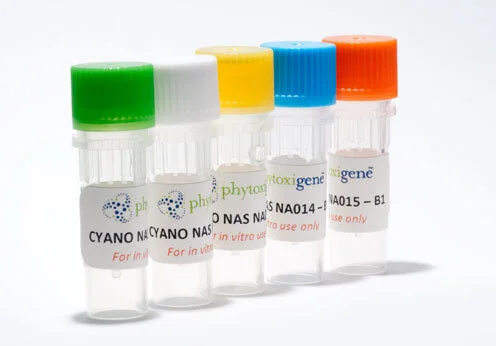Phytoxigene™ CyanoDTec is a molecular (DNA) based technology (Real Time PCR) that detects and quantifies the presence of Cyanobacteria, blue green algae, and their toxin producing genes in aquatic environments. Not all Cyanobacteria species produce toxins, therefore the presence of an algal bloom does not immediately defer a risk of toxins being present. The Phytoxigene™ test quantitates both the amount of overall Cyanobacteria present in a water sample along with the number of genes that are responsible for the production of the toxins. Toxins associated with blue green algae are either hepatatoxins (cause damage to the liver) and neurotoxins (cause neurological damage). The hepatatoxins include microcystin, nodularin and cylindrospermopsin while saxitoxin is the primary neurotoxin produced by Cyanobacteria.
Phytoxigene™ CyanoNAS are Nucleic Acid Standards for the CyanoDTec kit. The standards are accurate and standardised concentrations of the target genes used in the CyanoDTec test. The standards were commissioned and developed by the National Measurement Institute (NMI), a Division of the Australian Department of Industry and a particpant in the International Bureau of Weights and Measures (BIPM) Consultative Committee for Amount of Substance (CCQM). There are 5 standards in each kit 100, 1,000, 10,000 and 1,000,000 copies per reaction for the 16s ribosomal RNA gene of Cyanobacteria, and for each biotoxin gene target that is responsible for the production of microcystin and nodularin (mycE/ndaF) , cylindrospermopsin (cyrA) and saxitoxin (sxtA). The reference material has been designed to verify and/or validate methodologies for detecting toxin producing cyanobacteria using DNA-based technology.
Instructional Video of the CyanoDTec™ Assay Procedure
Phytoxigene™ DinoDTec: is a molecular (DNA) based technology (Real Time PCR) that detects and quantifies the presence of sxtA genes from saxitoxin producing Dinoflagellates. The assay is designed for the screening of environmental samples to identify potential blooms of PSP dinoflagellates. The abundance of sxtA genes has been shown to correlate with the abundance of the saxitoxin-producing species. Detection and quantification of sxtA in HAB events has also been correlated with saxitoxin uptake in shellfish.
Phytoxigene™ DinoNAS are Nucleic Acid Standards for the DinoDTec kit. The standards are accurate and standardised concentrations of the target genes used in the DinoDTec test. The standards were commissioned and developed by the National Measurement Institute (NMI), a Division of the Australian Department of Industry and a particpant in the International Bureau of Weights and Measures (BIPM) Consultative Committee for Amount of Substance (CCQM). There are 5 standards in each kit 100, 1,000, 10,000, 100,000 and 1,000,000 copies per reaction for the SxtA4 gene of toxin producing dinoflagellates.



